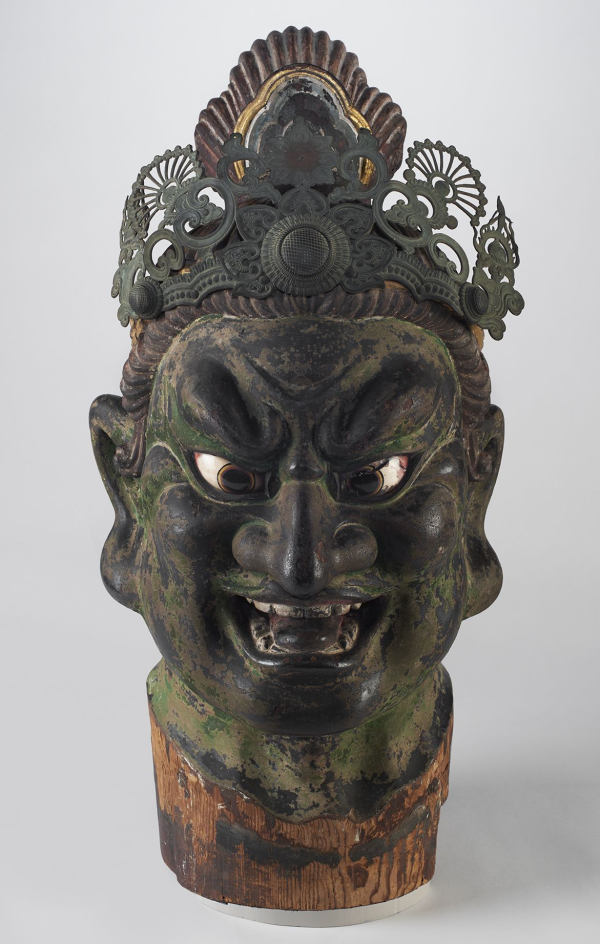
Head of a Guardian. Japan, Kamakura period (1185–1333), 13th century. Hinoki cypress wood with lacquer on cloth, pigment, rock crystal, metal, 221⁄16 × 101⁄4 × 1315⁄16 (56 × 26 × 35.5 cm). Brooklyn Museum; Gift of Mr. and Mrs. Alastair B. Martin, the Guennol Collection, 86.21. (Photo: Brooklyn Museum)

Head of a Guardian. Japan, Kamakura period (1185–1333), 13th century. Hinoki cypress wood with lacquer on cloth, pigment, rock crystal, metal, 221⁄16 × 101⁄4 × 1315⁄16 (56 × 26 × 35.5 cm). Brooklyn Museum; Gift of Mr. and Mrs. Alastair B. Martin, the Guennol Collection, 86.21. (Photo: Brooklyn Museum)
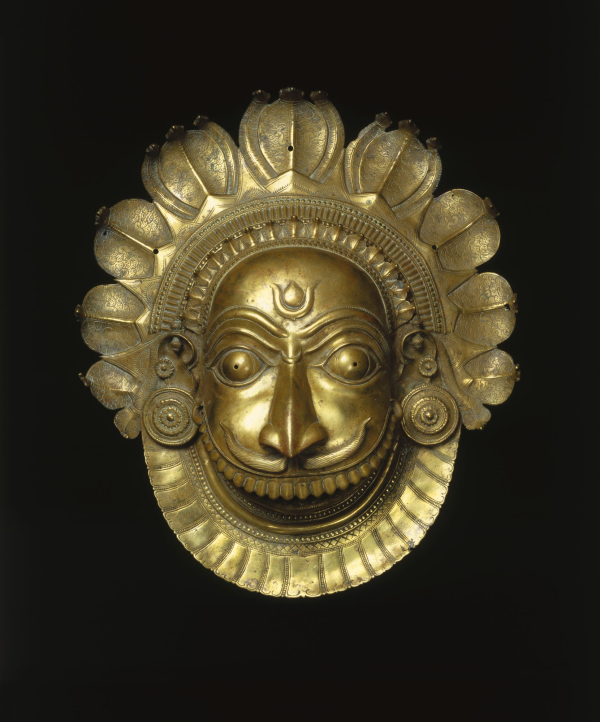
Mask of a Fierce Bhuta Deity. Western India (Karnataka), circa 18th century. Brass, 18 3/4 × 16 7/16 × 7 1/2 in. (47.6 × 41.8 × 19.1 cm). Brooklyn Museum; Purchase gift of Dr. Bertram H. Schaffner, 1996.24. (Photo: Brooklyn Museum)
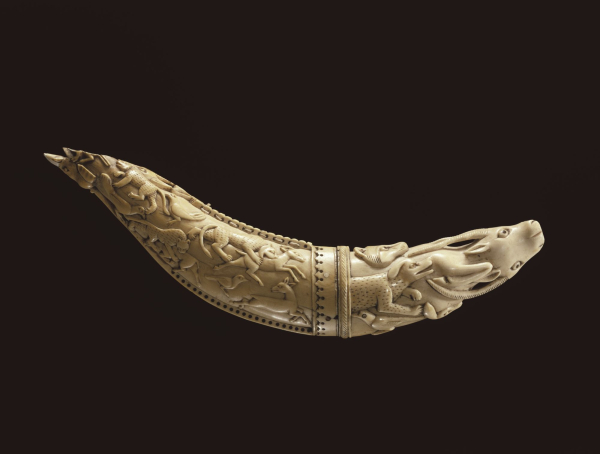
Priming Horn. Northern India, Mughal period, late 16th–early 17th century. Ivory, traces of color, 1 5/8 × 3 1/4 × 10 3/4 in. (4.1 × 8.3 × 27.3 cm). Brooklyn Museum; Gift of Mrs. Carl L. Selden, 82.128. (Photo: Brooklyn Museum)
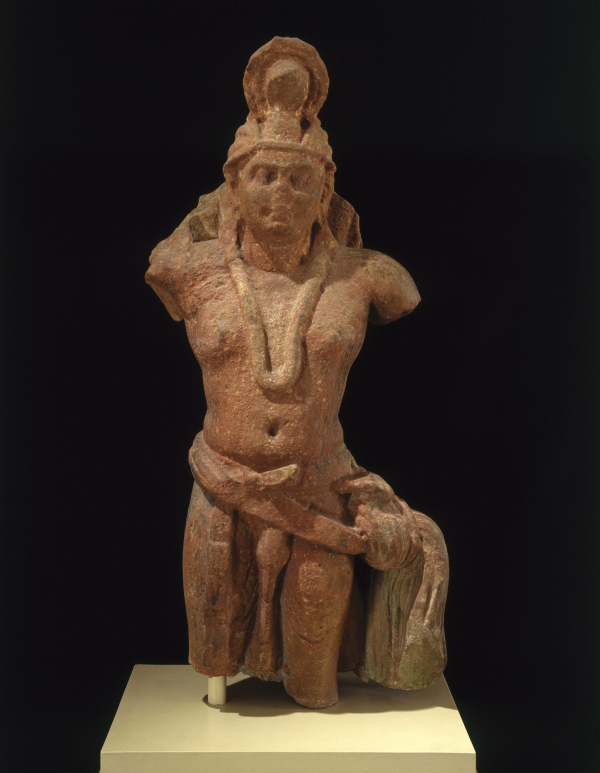
Serpent King (Nagaraja). Northern India (Uttar Pradesh, Mathura), Kushana period, 1st–2nd century C.E. Sandstone, 47 × 18 × 10 3/8 in. (119.4 × 45.7 × 26.4 cm). Brooklyn Museum; Frank L. Babbott Fund and A. Augustus Healy Fund, 67.202. (Photo: Brooklyn Museum)

Vishnu and Lakshmi with Vishnu’s Avatars. Northern India (Rajasthan), 10th century. Sandstone, 43 1/2 × 22 1/2 × 7 in. (110.5 × 57.2 × 17.8 cm). Brooklyn Museum; Purchase gift of the Charles Bloom Foundation, Inc., 86.191. (Photo: Brooklyn Museum)
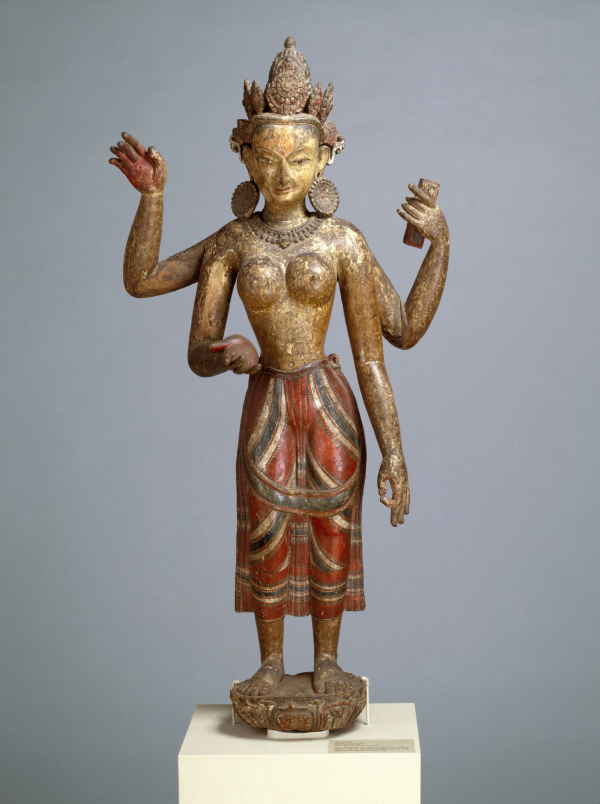
Vasudhara. Nepal, 16th century. Wood, pigment, 53 3/4 × 24 × 15 1/2 in. (136.5 × 61 × 39.4 cm). Brooklyn Museum; Gift of Dr. Bertram H. Schaffner, 86.137. (Photo: Brooklyn Museum)

Green Tara. India (Odisha, Cuttack Hills, Udayagiri or Ratnagiri), 8th century. Khondalite, 67 3/8 × 26 × 17 1/2 in., 1109 lb. (171.2 × 66 × 44.5 cm, 503.04 kg). Brooklyn Museum; Carll H. de Silver Fund and Ella C. Woodward Memorial Fund, 60.138. (Photo: Brooklyn Museum)
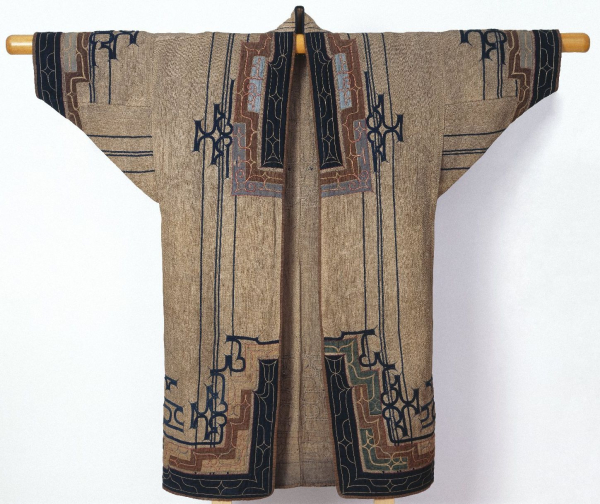
Woman's Robe. Japan, Ainu people, late 19th–early 20th century. Elm bark fiber cloth (attush) with appliqué and embroidery, 49 5/8 × 52 3/8 in. (126 × 133 cm). Brooklyn Museum; Gift of Herman Stutzer, 12.690. Creative Commons-BY. (Photo: Brooklyn Museum)

Head and Torso of a Buddha. Thailand, 14th century. Bronze, 38 × 22 1/2 × 11 in. (96.5 × 57.2 × 27.9 cm.). Brooklyn Museum; Purchased with funds given by the Charles Bloom Foundation, Inc., in memory of Mildred and Charles Bloom, 88.94. Creative Commons-BY. (Photo: Brooklyn Museum)

Pair of Earrings. Korea, Unified Silla period, 6th century C.E. Gold, probably over a lacquer core, length of each earring: 3 9/16 in. (9 cm). Brooklyn Museum; Gift of Theodora Wilbour and Jane Van Vleck, by exchange and Designated Purchase Fund, 2013.3a-b. (Photo: Brooklyn Museum)
Royal tombs near the Silla capital city, Gyeongju, in southeast Korea, have yielded sophisticated gold adornments including crowns and earrings. Elaborate pendants like these were either worn as earrings or suspended from the sides of royal crowns to mimic earrings. Granulation, or decoration with small individual gold beads, is applied to the sheathing of the earrings’ upper segment and used to outline the individual leaf shape of the gold spangles and lower leaves. The technique is thought to have developed in Mesopotamia around the eighteenth century B.C.E. and then spread to the Persian, Greek, and Roman empires, eventually traveling across the great Central Asia trade routes to China and the rest of East Asia. Its diffusion demonstrates the importance of Silk Road trade to East Asian material culture.

Ewer with Cover. Korea, Goryeo dynasty, first half 12th century. Stoneware with underglaze slip decoration and celadon glaze, 9 7/8 × 9 1/2 × 5 1/2 in. (25.1 × 24.1 × 14 cm). Brooklyn Museum; Gift of Mrs. Darwin R. James III, 56.138.1a-b. (Photo: Brooklyn Museum)
With its delicate modeling and restrained decoration, this botanically inspired vessel is considered one of the finest Korean ceramics in existence. The lid and body have fired to slightly different tones of green—probably because they were in separate areas of the kiln—but we know that they belong together, because the tiny white moth on the lid appears directly opposite the cocoon, from which it has just emerged, on the handle. Whereas the body of the ewer is made of light gray clay, the moth and cocoon are in white porcelain, a material that was new to Korean potters at the time. Also new was the addition of tiny white spots of slip (liquid clay) to highlight various elements of the vessel: these are a precursor to the inlaid decoration that would become the signature ornamentation on later Goryeo celadons.

Haniwa Figure of a Woman. Japan, Kofun period, 5th–6th century. Earthenware with traces of pigment, 18 × 8 3/4 × 7 1/2 in. (45.7 × 22.2 × 19.1 cm). Brooklyn Museum; Gift of Mr. and Mrs. Stanley Marcus, 79.278.1. (Photo: Brooklyn Museum)
Clay cylinders called haniwa were set into the ground around the large funerary mounds created during Japan’s Kofun period (circa 300–538 C.E.). Their original purpose was probably to mark and protect the periphery of the tomb. Many haniwa have been decorated to resemble houses, animals, or people; these likely represented the entourage and possessions that the deceased would need in the afterlife.
The figural haniwa appears to represent a female of high status, with jewelry and a shelf-like headdress. It is unusual that the pigment on her face and body survives. Because of her distinctive facial markings, she is sometimes identified as a holy woman or shaman, but it may be that many different types of women marked their faces during this period.

Ritual Wine Vessel (Guang). China, late Shang dynasty, 13th–11th century B.C.E. Bronze, 6 1/2 × 3 1/4 × 8 1/2 in. (16.5 × 8.3 × 21.6 cm). Brooklyn Museum; Gift of Mr. and Mrs. Alastair B. Martin, the Guennol Collection, 72.163a-b. (Photo: Brooklyn Museum)
This Shang-dynasty gong is the finest Chinese ritual bronze in the Museum’s collection. The lid is shaped like a dragon with a maniacal, toothy grin and protruding horns while the handle forms another beast. On the sides are two demon masks (taotie) with horns, fangs, and bulging eyes, and another two are found under the chin and tail of the beast. In total, twenty dragons, birds, and mythical creatures morph into each other on the lid and body of the vessel, illustrating the spiritual transformation that the ancient Chinese believed occurs when communicating with ancestors, or when leaving this world for the afterlife to become an ancestor oneself. Such vessels were used for pouring wine offerings on ancestral altars or during ritual banquets by Shang kings, who served as the communication links between the living and their ancestors.
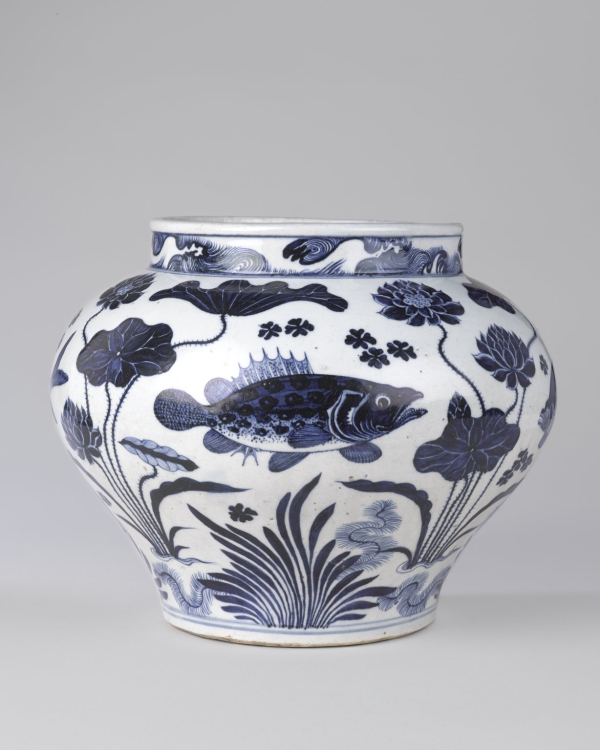
Wine Jar with Fish and Aquatic Plants. China, Yuan dynasty, 14th century. Porcelain with underglaze cobalt blue decoration, 11 15/16 × 13 3/4 in. (30.3 × 34.9 cm). Brooklyn Museum; The William E. Hutchins Collection, Bequest of Augustus S. Hutchins, 52.87.1. (Photo: Brooklyn Museum)
This masterpiece of Chinese porcelain is an important example of early blue-and-white ware from the imperially sponsored kilns of Jingdezhen in Jiangxi province. Four fish—mackerel, whitefish, carp, and freshwater perch—are depicted swimming along the hip of the vessel; their Chinese names form a rebus for the phrase “honest and incorruptible” (qingbai lianjie). The visual wordplay suggests that the jar may have been made for an elite clientele who, it was hoped, would be inspired by the rebus’s message of rectitude while drinking their wine. The twisting leaves and stems of the eelgrass, blossoming lotuses, and other flora elegantly frame the fish and evoke the teeming pulse of the ocean. The mineral cobalt for the rich blue color was imported from western Asian sources, and similar porcelains were often made for the Middle Eastern export market.
The wine jar was part of a large bequest of Chinese ceramics from the Hutchins family collection in Long Island. The Brooklyn Museum curator George Lee (active 1949–59) described finding the vessel when he went to survey the collection in 1952: After other ceramics were loaded onto the Museum’s truck, he went to the garage to wash his hands. There, he found this wine jar below the sink, catching water drops. It was put on the truck and would become one of the Museum’s greatest treasures.

Dragon Jar. Korea, Joseon dynasty, mid-17th century. Porcelain with iron-painted decoration under clear glaze, overall: 12 11/16 × 14 9/16 in. (32.2 × 37 cm). Brooklyn Museum; Gift of the Asian Art Council, 86.139. (Photo: Brooklyn Museum)
By the seventeenth century, porcelain had overtaken stoneware as the ceramic of choice for wealthy Koreans and underglaze brown—once favored for decoration of Buncheong stonewares—enjoyed a brief revival, this time on porcelain vessels. These large, bulbous storage jars were formed by joining two bowls, one inverted on top of the other. The swelling surfaces of the jars give dimension and energy to curvilinear forms, as seen in particular in the swirl of the highly abstracted dragon.
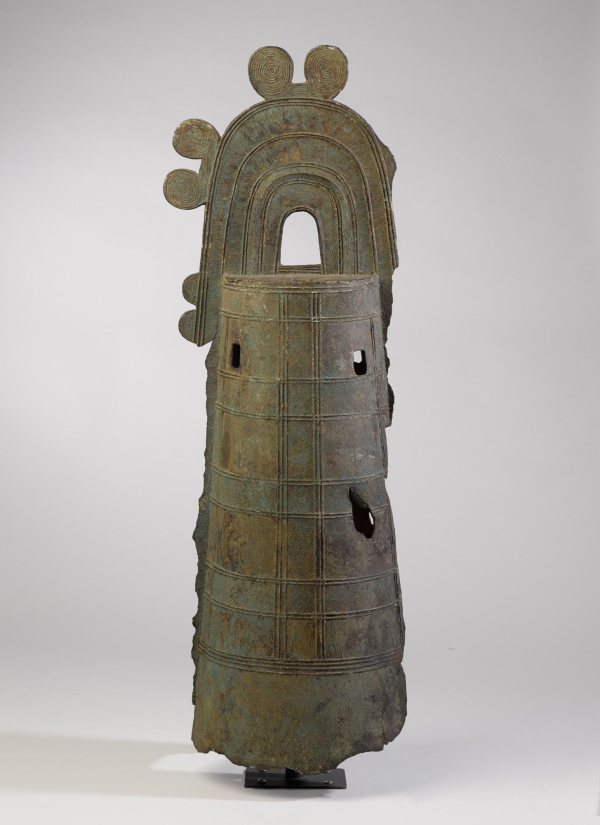
Bell-Shaped Ritual Object (Dotaku). Japan, middle to late Yayoi period, 100–300 C.E. Bronze, 34 1/2 × 11 1/2 in. (87.6 × 29.2 cm). Brooklyn Museum; Gift of Mr. and Mrs. Milton J. Lowenthal, 67.198. (Photo: Brooklyn Museum)
Bronze objects known as dōtaku have been found deliberately buried along with other ritual objects at ancient agricultural sites throughout the western part of Honshū Island. Although their shape is clearly inspired by that of a hanging bell, they do not ring when struck because their walls are too thinly cast. The purpose of the dōtaku remains mysterious, but the fact that they were buried suggests that they were offerings for the earth, probably made as part of rituals to ensure bountiful crops.

Shrine with an Image of the Buddha Amitayus. China, Qing dynasty, Qianlong period, 1736–95. Enamel on copper alloy, gilt bronze, semiprecious stones, 25 1/4 × 14 3/8 × 10 5/8 in. (64.1 × 36.5 × 27 cm). Brooklyn Museum; Gift of Samuel P. Avery, Jr., 09.520a-b. (Photo: Brooklyn Museum)
Arts of Asia
Long-Term Installation
Arts of Asia and the Islamic World, 2nd Floor
 Now featured on Bloomberg Connects
Now featured on Bloomberg Connects
We house one of America’s foremost collections of Asian art, now displayed in newly renovated galleries. We have completed a multiyear reinstallation that celebrates the great diversity of Asian art by presenting works from Japan, Korea, China, South and Southeast Asia, and the Himalayas, as well as the arts of Buddhism.
The Arts of Japan gallery features traditional forms such as paintings, woodblock prints, sculptures, and lacquerwares. We have a large, historical collection of art made by the Ainu people of northern Japan, which is prominent in the gallery, as is our important collection of ceramics by modern and contemporary masters.
Among the first U.S. institutions to collect and exhibit Korean art, we hold one of the country’s premier collections. The Arts of Korea gallery offers a full range of traditional ceramic wares as well as fine paintings, costumes, home furnishings, and religious arts.
The Arts of China gallery ranges from the Neolithic era (circa 3000 B.C.E.) to today. Objects in a wide variety of mediums reveal the sophistication of Chinese artistry and reflect Chinese religious, political, and intellectual traditions that continue to evolve.
The Arts of Buddhism gallery offers an introduction to Buddhism through its art forms, featuring art from multiple Asian cultures. Juxtaposed icons of Buddhas, Bodhisattvas, and other enlightened figures, as well as tools used in worship, illustrate regional variations in practice and aesthetics.
Arts of Southeast Asia highlights our collection of historical art from the region, with a primary focus on sculpture depicting Hindu and Buddhist deities.
The largest gallery in the suite, Arts of South Asia showcases our important holdings of art from India and surrounding regions, featuring stone sculptures from Hindu and Jain temples. Celebrating a diversity of forms and traditions, the installation includes highlights from our extensive collections of manuscript paintings and early terracotta sculptures as well as decorative objects and architectural elements.
The smallest gallery in the suite, Arts of the Himalayas features sculpture and paintings from Nepal, Tibet, and neighboring regions, most of it made for use in Buddhist or Hindu religious practices.
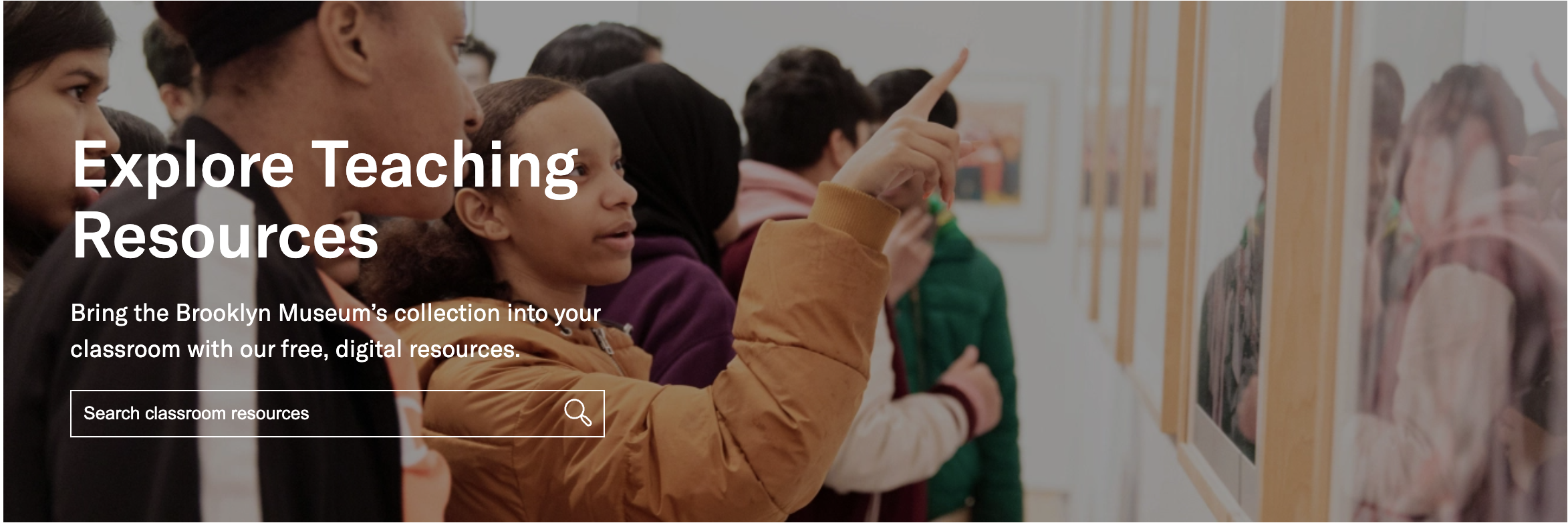
Bring the Brooklyn Museum’s collection into your classroom with our free, digital resources! Visit teach.brooklynmuseum.org to explore lesson plans, activities, and more, designed to deepen students' learning through the arts. Now featuring lesson plans for Arts of China and Arts of East Asia.
The Arts of Asia galleries are organized by Joan Cummins, Lisa and Bernard Selz Senior Curator, Asian Art, in collaboration with Susan Beningson (Arts of China) and Alison Baldassano (Arts of the Himalayas).
The reinstallation of the Arts of Korea gallery is made possible by the National Museum of Korea and Young Hwan Jeong.
The reinstallation of the Arts of Japan gallery is made possible by leadership support from Johanna and Laurent Alpert; Wanyong and Christopher Austin; Alan L. Beller; Constance Christensen; Katharine and Peter Darrow; Jamie and Robert P. Davis; William F. Gorin; Michele Hertz and Lawrence Friedman; Collie and Charles Hutter, Karl and Jennifer Hutter, and Katherine and Eric Mason; Danielle and Jeff Karpf; Claudia and Wilson Langworthy; Joan B. Mirviss and Robert J. Levine; Barbara F. and Richard W. Moore; Annie Paulsen and Al Garner; Leslie and David Puth; Elizabeth A. Sackler; Jennifer Sage and Nicolas Grabar; Anna and George Sampas; and Wendy and Stephen Shalen. These generous gifts were made in honor of longtime Brooklyn Museum Trustee Leslie Langworthy Beller (1951–2017).
The reinstallation of the Arts of China gallery is made possible by leadership support from the E. Rhodes and Leona B. Carpenter Foundation. Major support is provided by The Freeman Foundation.
Major support for the reinstallation of the Arts of Southeast Asia gallery is made possible by an anonymous donor.
The reinstallation of the Arts of South Asia gallery is made possible by gifts from numerous donors, with major support from John and Carol Rutherford. This project is supported in part by the National Endowment for the Arts.
Leadership support for the reinstallation of the Arts of Asia galleries is provided by

Additional support is provided by Ellie and Edgar Cullman, Lisa and Bernard Selz, and Gary M. Smith and Teresa Kirby.